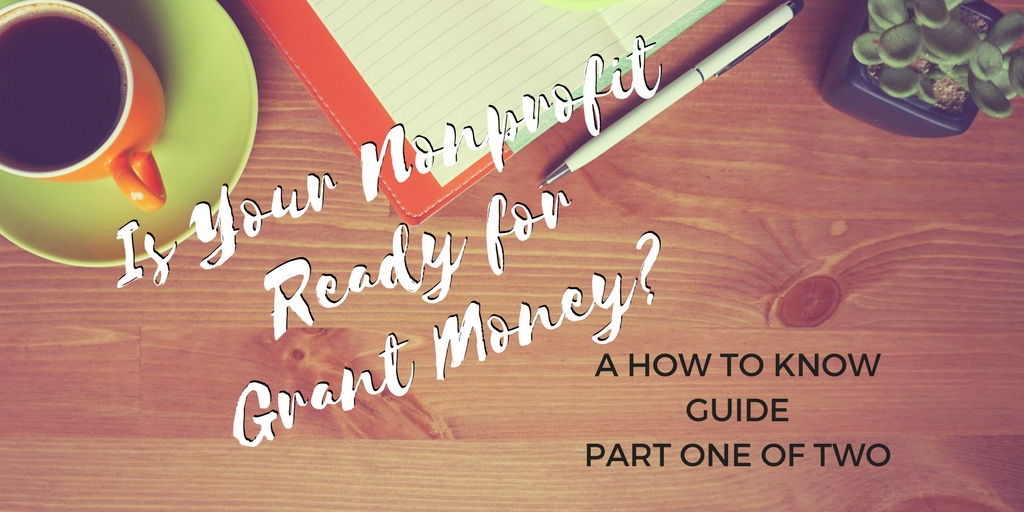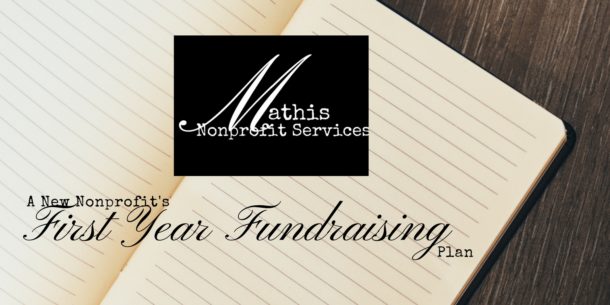This is part one of a two-part series.
New and small nonprofits often think of Grants as easy funding sources. Grants are not easy. They require some work on your nonprofit’s part and may come with strings. Even with that said, grants should be part of a nonprofit fundraising plan. Jumping into a grant without the necessary legwork and readiness from your organization will only set yourself up for failure.
So what does your organization need to be ready?
I have divided the activities needed into four categories: organizational, operational, financial, and programmatic. Most of these categories in activities are covered in A New Nonprofit’s 9 Action Step Guide to a Successful Nonprofit.
Organizational
First and foremost, your organization needs to have been Incorporated with Articles of Incorporation and have your 501( c) 3 tax-exempt status.
Next, you need a mission statement. The mission statement is important because aligning your mission with Foundations is the first step to Grant success. Your mission statement should be unique, clear, and doable. Your mission should be something that another nonprofit isn’t doing. You want to be able to different differentiate your organization from others in your area. Foundations will not find organizations that duplicate or overlap seller services in their geographic area. Clearly State your mission. There should be no doubt why you are a non-profit. Last, make sure your mission is doable. Wanting to help people isn’t enough.
It should be no surprise that Foundations hold a Board of Directors in high regards. Why? Your Board is your leadership. They provide focus and realize the mission with effective methods, productive partnerships, and thoughtful goal setting. Boards have a responsibility to make sure the organization is operating legally. Your Board must have these characteristics to provide a strong grant proposal:
- Be active and meet monthly;
- Take the lead on fundraising and connect the organization with donors and funders;
- Is diverse in expertise and ethnicity who mirrors your target population;
- Has committees; and
- Invest time and money.
You might also consider an Advisory Board with community participation to augment your Board. Funders like to see communities investing in your organization too.
A strategic plan needs to be part of your organization. This plan should be multi-year. The 9 Step Guide recommends A Five-Year Plan. When making out your strategic plan, keep in mind that Foundations consider a nonprofit new for their first three years. You may want to include that time frame in your 5-year strategic plan. This is also a plan that you must execute and evaluate. The Strategic plan will be of no use to you in writing a grant if you can’t prove your you’ve been working toward those goals.
Last, you need to have a tactical plan with SMART goals for 12 months. (You can download your SMART goals worksheet here.) This plan should list your goals and Milestones action steps to reach those goals. The 9 Step Guide’s step three has more detail.
Goals to work toward
- History of success- Foundations will want to know you’re able to accomplish what you say you will. Begin keeping track of goal successes.
- Business plan- strategic plans are a little higher on the list but a business plan will let funders know you are serious.
- Letters of support from Community leaders and organizations- these letters can help you get grants because they let the foundation know you have support outside your organization.
- Document recent recognition- Did you get a community award or recognition? Is there an article in the paper done on you? Make sure you keep these things along with a file document date and what it was for.
Operational
First, you will need to have your 501( c) 3 tax-exempt letter in hand and an EIN (Employer Identification Number). These will be documents Foundations will ask for when you submit your letter of inquiry or proposal.
Next, set up your operational systems. These systems will include those spelled out in The 9 Step Action Guide and a system for reporting requirements to local, state, and federal agencies. You will need to create systems for effective operation of the organization. Hiring a qualified Executive Director to run the day to operations may also be needed at this point. Having someone full or part-time with excellent leadership skills would be necessary if you decide to hire.
In the operations of your nonprofit, you and your Board may decide partnerships will help further your mission. Foundations like to see nonprofits who are connected and supported by their community.
If you decide to seek federal grants, there are some extra steps you’ll need to take. You will need to register at grants.gov and sam.gov. You will also need to get a DUNS number.
As I have said, Foundations like community involvement. One way to develop community involvement is through a volunteer program. Developing a program and keeping track of volunteer hours can help in the grant proposal.
Last, make sure you are ready to pursue grants. Figure out who will write the grant. Do you have a grant calendar? Do you have someone to contact Foundations and begin forming relationships? These things will be necessary for you to figure out before writing a grant.
Goals moving forward:
- Establish your organizational systems. But they systems in writing.
- Begin forming a plan to increase Community engagement.
- Identify the grant writer and create a grant calendar.
Next week, I will talk about the Financial and Programmatic activities you will need for a successful grant.
Bonus Content List:
A New Nonproft’s 9 Step Action Guide to a Successful Nonprofit


 Most nonprofit leaders lay awake at night trying to figure out how to fund their mission.
Hi! I'm Alesha.
I teach sustainable fundraising in a way that they can take action today so they can serve their clients.
I can help you move from just getting started funding your new nonprofit to gaining confidence in your fundraising and building relationships to knowing what works for your organization and looking at the infinite game when it comes to funding. I’ve worked with nonprofit Founders and written the book I HAVE MY 501(C)3! NOW WHAT?!? Your Blueprint to Starting Your Nonprofit Without Being the Sole Funder that lays the foundations for funding in a new nonprofit.
I’ve worked in Development (Fundraising) Departments in large organizations and I know the no cost, low-cost methods they use to bring in funding. I bring those sound strategies to the nonprofits I serve.
Most nonprofit leaders lay awake at night trying to figure out how to fund their mission.
Hi! I'm Alesha.
I teach sustainable fundraising in a way that they can take action today so they can serve their clients.
I can help you move from just getting started funding your new nonprofit to gaining confidence in your fundraising and building relationships to knowing what works for your organization and looking at the infinite game when it comes to funding. I’ve worked with nonprofit Founders and written the book I HAVE MY 501(C)3! NOW WHAT?!? Your Blueprint to Starting Your Nonprofit Without Being the Sole Funder that lays the foundations for funding in a new nonprofit.
I’ve worked in Development (Fundraising) Departments in large organizations and I know the no cost, low-cost methods they use to bring in funding. I bring those sound strategies to the nonprofits I serve.